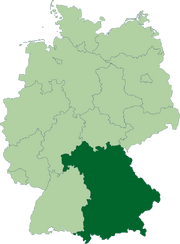
The state of Bavaria, as modernly defined.

Flag of Bavaria
Bavaria, formally the Free State of Bavaria (German: Freistaat Bayern, pronounced [ˈfʁaɪʃtaːt ˈbaɪ.ɐn]; Austro-Bavarian: Freistood Boajan/Baijaan) is a state of Germany, located in the southeast of the country. It is the largest German state by area, forming almost 20% of the total land area of Germany. Its capital is Munich.
One of the oldest states of Europe, Bavaria was established as a duchy in the mid 1st millennium. Modern Bavaria also includes parts of the historical regions of Franconia and Swabia.
Bavaria in 1632[]
When Grantville arrived in 1631, Bavaria was a center of the Counter-Reformation and a key member of the German Catholic League. Unusually for German states of the time, Bavaria practiced primogeniture, and had done so since the 16th century. This was supported with the reasoning that Bavaria would only remain a strong force within the Holy Roman Empire if it remained unified.
Following the loss of the Upper Palatinate in 1632, Bavaria controlled no territory north of the Danube, except for the area around Ingolstadt. Also, the United States of Europe controlled some territory south of the Danube. Bavaria's western border was essentially the line of the Lech. West of the Lech was USE-administered Swabia, essentially occupied by Gustav Horn.
Still, Bavaria had actually benefited from the effect Grantville had on the course of the Thirty Years' War. Unlike the OTL, in which Gustavus Adolphus entered Munich in May of 1632, Bavaria's core territory had not, as of the summer of 1634, been a theatre of war, and had not been significantly affected by it.[1] Bavaria did not really feel the effects of war until Duke Maximilian decided to mobilize in response to Johan Banér's crossing of the Danube during the siege of Ingolstadt.
In the mid-1630's, following the "Bavarian Crisis", Bavaria's succession was on shaky ground. Duke Maximilian was in his sixties, childless, and had apparently decided that he would never remarry. His only heirs were his outlawed brother Albrecht's two surviving sons, who were minors that were effectively being held hostage in the USE.
In March of 1636, Gustavus Adolphus ordered Mike Stearns to take the Third Division of the USE Army to Bavaria and "crush" Maximilian.
The defense of both Bavaria and occupied Ingolstadt was left to the command of Ottavio Piccolomini. Despite managing a tactical victory against the Hangman Regiment, he was forced to withdraw. He discovered that the USE Third Army had outflanked him weeks ago.
In August of 1636, Maximilian's court negotiated a settlement with the USE. Under that settlement, Maximilian went into exile in Italy, and Albrecht became the new Duke of Bavaria. Bavaria became a protectorate of the United States of Europe, with Gustavus as "Lord Protector", as Gustavus did not want to formally incorporate an area that was both large and staunchly Catholic into the USE's provincial structure.
References[]
- ↑ 1634: The Bavarian Crisis, ch. 39